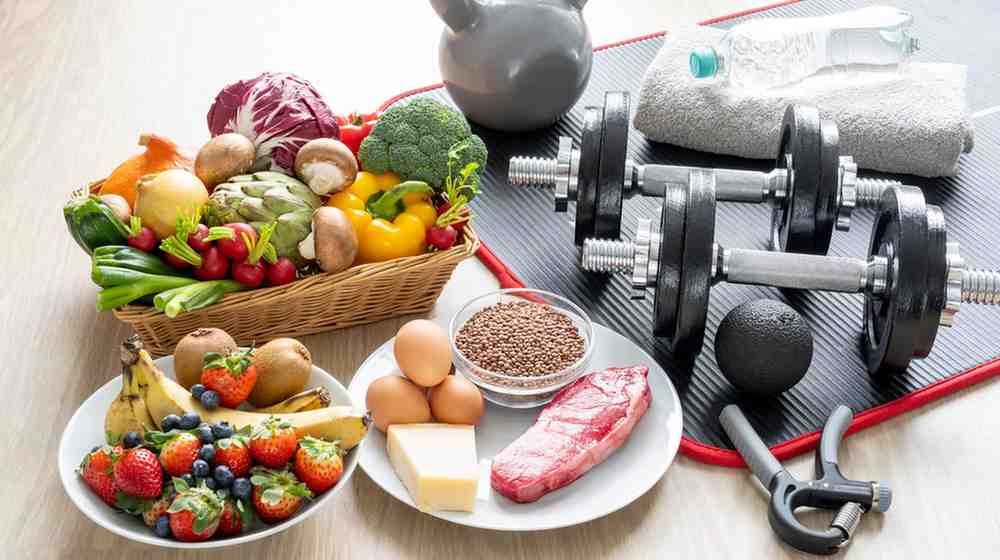Whether you’re getting into bodybuilding or simply want to increase your muscle mass, knowing how to build muscle has a series of benefits, including increased strength and muscular endurance.
Muscle mass is the straw that stirs the drink in the sport of bodybuilding. Talk all you want about symmetry, shape, and definition, but in the final analysis, muscle mass is the defining element of a physique. The mass-building equation has three components: a correct diet strategy, hardcore training, and high-tech supplementation. It’s not rocket science, but there are tricks to it, nonetheless.
To save you time and trouble, I’ve compiled 10 tips to jump-start anabolism and create a positive nitrogen balance—to pack on muscle mass, you need to take in more nitrogen via protein and training than you excrete through the natural metabolic process. Learn how to gain muscle and find your fitness sweet spot.
Tips on How to Gain Muscle Quickly
How to Gain Muscle Quickly. Is there really a good answer to the question ‘how to gain muscle quickly’? Basically, if you’re disciplined enough to follow a regular workout routine and eat a balanced and sensible diet, it really is possible to gain muscle quite quickly, or at least more quickly than you might have thought.

You need to begin your workouts steadily and then increase them to the rate of 6 days a week, but to avoid overworking your muscles and risking injury, follow a split training program something like the one detailed below:
- Maximize Muscle Building
“Maximize muscle building” refers to the process of optimizing and maximizing the growth and development of muscle tissue in the body. It involves implementing strategies and techniques to achieve the greatest possible gains in muscle size, strength, and definition. The goal is to stimulate the muscles to adapt and grow through proper nutrition, targeted resistance training, and adequate recovery.
To maximize muscle building, individuals typically focus on several key aspects:
Nutrition:
Consuming a balanced and nutrient-dense diet that supports muscle growth is essential. This includes consuming sufficient calories to provide energy for muscle development and repair, as well as consuming an adequate amount of protein to supply the necessary building blocks (amino acids) for muscle tissue synthesis.
Resistance Training:
Engaging in regular and progressive resistance training exercises is crucial for stimulating muscle growth. This involves performing exercises that target specific muscle groups and progressively increasing the intensity, volume, and complexity of the workouts over time.
Progressive Overload:
Continuously challenging the muscles by progressively increasing the demands placed on them. This can be achieved by increasing the resistance (weight), the number of repetitions, or the intensity of the exercises. Progressive overload stimulates muscle adaptation and triggers growth.
Recovery:
Allowing sufficient time for rest and recovery is vital for muscle growth. This includes getting enough sleep, which is when the body repairs and rebuilds muscle tissue. Additionally, incorporating rest days into the training program to allow the muscles to recover and prevent overtraining is essential.
Consistency:
Consistently following a structured training and nutrition plan is crucial for maximizing muscle building. Regularly engaging in resistance training, adhering to proper nutrition, and maintaining a consistent routine will yield better results over time.
Individual Factors:
It’s important to recognize that individual factors such as genetics, age, hormonal levels, and overall health can influence muscle-building potential. While everyone can benefit from maximizing muscle building, the rate and extent of muscle growth may vary among individuals.
By implementing these strategies and maintaining a disciplined approach, individuals can strive to maximize muscle building and achieve their desired muscle size, strength, and overall physique. It’s important to note that the process takes time, dedication, and consistency, and results may vary depending on individual factors. Consulting with a fitness professional or a registered dietitian can provide personalized guidance to help optimize muscle-building efforts.
2. Eat More
When it comes to building muscle, proper nutrition is crucial. To support muscle growth, you need to consume an adequate amount of calories and provide your body with the necessary nutrients. Here are some tips to help you eat more effectively for muscle building:

Calorie Surplus:
To gain muscle, you need to consume more calories than your body burns in a day. This is known as a calorie surplus. Calculate your daily calorie needs using an online calculator and aim to eat around 250-500 calories above that number.
Macronutrient Balance:
Ensure you’re getting enough protein, carbohydrates, and healthy fats in your diet.
Protein: Protein is essential for muscle repair and growth. Aim for around 0.7-1 gram of protein per pound of body weight per day. Good sources include lean meats, poultry, fish, eggs, dairy products, legumes, and plant-based proteins like tofu and tempeh.
Carbohydrates:
Carbs provide energy for your workouts. Opt for complex carbohydrates such as whole grains, fruits, vegetables, and legumes. These sources also provide essential vitamins, minerals, and fiber.
Healthy Fats:
Include sources of healthy fats in your diet, such as avocados, nuts, seeds, olive oil, and fatty fish. Healthy fats help with hormone production and overall health.
Frequent Meals:
Rather than eating three large meals, aim for 5-6 smaller meals throughout the day. This approach helps ensure a constant supply of nutrients for muscle repair and growth.
Nutrient-Dense Foods:
Focus on consuming nutrient-dense foods to make the most of your calorie intake. Choose foods like lean meats, whole grains, fruits, vegetables, and healthy fats, as they provide a wide range of vitamins, minerals, and antioxidants.
Pre- and Post-Workout Nutrition:
Consume a meal or snack containing protein and carbohydrates before your workout to provide energy and amino acids for muscle repair. After your workout, have a protein-rich meal or snack to support recovery and muscle growth.
Hydration:
Drink enough water throughout the day to stay properly hydrated. Water plays a crucial role in numerous bodily functions, including muscle function and recovery.
Track Your Progress:
Monitor your weight, body measurements, and strength gains to assess if you’re consuming enough calories to support muscle growth. Adjust your intake as needed.
Remember that consistency is key in both nutrition and exercise. Consult with a registered dietitian or a sports nutritionist to personalize your dietary plan based on your specific needs and goals.
3. Work Big, Not Small
When it comes to muscle bodybuilding, the concept of “working big, not small” typically refers to prioritizing compound exercises over isolation exercises. Compound exercises involve multiple muscle groups and joints, allowing you to lift heavier weights and stimulate more overall muscle growth.

Here are a few reasons why working big with compound exercises can be beneficial for muscle bodybuilding:
Increased muscle activation:
Compound exercises like squats, deadlifts, bench presses, and overhead presses engage multiple muscle groups simultaneously, leading to greater overall muscle activation. This can result in better muscle development and strength gains.
Hormonal response:
Compound exercises have been shown to elicit a greater hormonal response compared to isolation exercises. These exercises stimulate the release of anabolic hormones like testosterone and growth hormone, which are crucial for muscle growth.
Efficient use of time:
Compound exercises allow you to work multiple muscle groups in a single movement, making your workouts more time-efficient. Instead of spending excessive time on individual muscles with isolation exercises, you can target multiple areas simultaneously.
Functional strength:
Compound exercises mimic movements in daily life or sports activities that require the coordination of multiple muscle groups. By focusing on these movements, you can develop functional strength that translates into better performance in various physical activities.
Core stabilization:
Many compound exercises require core stabilization to maintain proper form and balance. Strengthening your core muscles through compound movements not only enhances your overall strength but also improves posture and reduces the risk of injuries.
While compound exercises are essential for muscle building, it’s important to note that isolation exercises still have their place. Isolation exercises can help target specific muscle groups, address muscular imbalances, and provide additional volume and definition to certain areas.
To design an effective muscle-building workout routine, it’s best to include a combination of compound exercises and isolation exercises. The specific exercises, sets, and reps can vary based on your goals, fitness level, and preferences. Consulting with a qualified fitness professional or personal trainer can be beneficial in creating a personalized program tailored to your needs.
4. Train Heavy muscle gain
To train for heavy muscle gain, you’ll need to focus on a combination of resistance training, proper nutrition, and adequate rest. Here’s a step-by-step guide to help you:

Set clear goals:
Define your specific muscle gain goals. Do you want to increase overall muscle mass or target specific muscle groups? Having a clear goal will help you design an effective training program.
Resistance training:
Perform compound exercises that target multiple muscle groups simultaneously. These exercises stimulate the release of growth hormones and testosterone, which are essential for muscle growth. Focus on exercises like squats, deadlifts, bench presses, overhead presses, rows, and pull-ups.
Progressive overload:
Gradually increase the intensity of your workouts over time. This can be achieved by increasing the weight, reps, or sets. Progressive overload ensures that your muscles are constantly challenged, promoting muscle growth.
Split your workouts:
Divide your training sessions into different muscle groups or body parts to allow for proper recovery. For example, you could have a day dedicated to legs, another for chest and triceps, and another for back and biceps. This approach ensures that each muscle group gets adequate attention and recovery time.
High-intensity training:
Incorporate techniques such as supersets, drop sets, and rest-pause sets to maximize muscle stimulation. These methods help exhaust the muscles and promote hypertrophy.
Nutrition:
Proper nutrition is crucial for muscle growth. Consume a diet that is rich in lean protein sources such as chicken, fish, eggs, and plant-based protein. Aim for a calorie surplus to support muscle growth, but make sure the surplus comes from nutritious foods rather than junk food.
Macronutrient distribution:
Distribute your macronutrients appropriately. Consume around 1.2-2 grams of protein per kilogram of body weight to support muscle repair and growth. Include healthy fats and complex carbohydrates in your diet for energy and overall health.
Stay hydrated:
Drink plenty of water throughout the day to support muscle function, recovery, and overall well-being.
Recovery:
Allow your body enough time to rest and recover between workouts. Muscles grow during the rest phase, so avoid overtraining. Get enough sleep each night to optimize recovery and hormone production.
Consistency and patience:
Building muscle takes time and consistency. Stick to your training plan, nutrition, and recovery routine consistently, and be patient. Results will come with dedication and perseverance.
Remember, it’s always a good idea to consult with a fitness professional or personal trainer to help you design a program that suits your specific needs and goals.
5. Have a Drink First
If you’re referring to consuming an alcoholic drink before or during your workout to enhance muscle gain, it is generally not recommended. Alcohol consumption can have several negative effects on your muscle-building efforts. Here’s why:

Impaired performance:
Alcohol acts as a depressant, which can impair your coordination, balance, and reaction time. This can negatively impact your exercise performance and increase the risk of injury.
Decreased muscle protein synthesis:
Alcohol consumption can decrease muscle protein synthesis, the process that leads to muscle growth and repair. This can hinder your muscle-building progress and recovery.
Nutrient interference:
Alcohol can interfere with the absorption and utilization of important nutrients that are crucial for muscle growth, such as protein, vitamins, and minerals. It can also deplete your body with essential nutrients.
Increased calorie intake:
Alcoholic beverages are often high in calories and low in nutritional value. Excessive alcohol consumption can lead to weight gain, which can make it harder to achieve your muscle gain goals.
Dehydration:
Alcohol is a diuretic, which means it increases urine production and can lead to dehydration. Proper hydration is essential for muscle function, recovery, and overall health.
If you choose to consume alcohol, it’s best to do so in moderation and separate it from your workout sessions. Prioritize your nutrition, hydration, and recovery to optimize your muscle gain efforts. If you have specific concerns or health conditions, it’s always best to consult with a healthcare professional.
6. Don’t Always Go Hard
You’re absolutely right. When it comes to muscle gain, it’s important to find a balance between intensity and recovery. While challenging workouts are necessary to stimulate muscle growth, overtraining and not allowing sufficient recovery can hinder your progress. Here are a few reasons why it’s important to avoid always going hard:
Muscle fatigue and injury: Constantly pushing yourself to the limits without adequate rest can lead to muscle fatigue and increase the risk of injury. Your muscles need time to repair and rebuild after intense workouts.

Central nervous system (CNS) fatigue:
Frequent intense workouts can tax your central nervous system. Your CNS plays a vital role in muscle activation and recovery. Over time, excessive stress on the CNS can lead to diminished performance and hinder muscle growth.
Plateau in progress:
Your body needs time to adapt to the stress placed upon it during workouts. By allowing for proper recovery, you provide your muscles with the opportunity to grow stronger and make progress. Without sufficient recovery, you may hit a plateau and see diminished results.
Hormonal balance:
Overtraining can disrupt the hormonal balance in your body. Hormones such as cortisol, which is associated with stress, can increase, while anabolic hormones like testosterone can decrease. This hormonal imbalance can negatively affect muscle growth and recovery.
Mental fatigue and burnout:
Constantly pushing yourself to the limit can lead to mental fatigue and burnout. It’s important to listen to your body and provide yourself with regular breaks to maintain motivation and long-term consistency in your training.
To optimize muscle gain, incorporate periods of active recovery into your training routine. This can include lighter workouts, active rest days, or even complete days off from training. Additionally, prioritize sleep, proper nutrition, and stress management techniques to support your recovery process.
Remember, muscle growth occurs during the recovery phase, so give your body the time it needs to rebuild and come back stronger.
7. Down the Carbs After Your Workout
After a workout, it’s essential to refuel your body with the right nutrients, including carbohydrates. Carbohydrates are the primary source of energy for your muscles, and consuming them after a workout helps replenish glycogen stores and promotes muscle recovery. Here are some tips for incorporating carbs into your post-workout routine:

Timing:
Try to consume your carbohydrates within 30 minutes to an hour after your workout. During this time, your body is most receptive to replenishing glycogen stores.
Opt for complex carbohydrates:
Focus on consuming complex carbohydrates rather than simple sugars. Complex carbs, such as whole grains, fruits, and vegetables, provide a steady release of energy and are more nutritious than simple sugars found in processed foods.
Protein-carb balance:
Combining carbohydrates with a source of protein can enhance muscle recovery. Aim for a ratio of around 3:1 or 4:1 of carbohydrates to protein in your post-workout meal or snack. This can be achieved through options like a chicken and quinoa salad, a turkey sandwich on whole wheat bread, or a smoothie with fruit and protein powder.
Don’t forget hydration:
Alongside carbohydrates, remember to rehydrate your body after a workout. Water is typically sufficient for most workouts, but if it was particularly intense or prolonged, you may consider a sports drink or electrolyte-rich beverage to replenish lost electrolytes.
Portion control:
While it’s important to refuel with carbohydrates, it’s also crucial to consider portion control and your overall daily calorie needs. Consuming excessive carbohydrates beyond what your body requires may lead to weight gain over time.
Remember, these tips are general guidelines, and individual nutritional needs may vary. It’s always a good idea to consult with a registered dietitian or a healthcare professional for personalized advice based on your specific goals and dietary requirements.
8. Challenge Yourself with Progressive Overload
Progressive overload is a principle commonly used in fitness and strength training to continually challenge your body and stimulate growth and improvement. The basic idea behind progressive overload is to gradually increase the demands placed on your body over time, forcing it to adapt and become stronger or more efficient. Here are some ways you can apply progressive overload to challenge yourself and achieve better results:

Increase resistance:
When it comes to strength training, increasing the amount of weight you lift is one of the most straightforward ways to apply progressive overload. Gradually add more weight to your exercises as you become stronger. For example, if you’re squatting 100 pounds, try increasing it to 105 pounds or more in subsequent workouts.
Adjust repetitions and sets:
Another way to challenge yourself is by adjusting the number of repetitions and sets you perform. As you get stronger, consider adding more sets or increasing the number of repetitions for each exercise. This increased volume puts greater stress on your muscles, leading to adaptation and growth.
Decrease rest intervals:
Manipulating your rest periods can also be an effective way to apply progressive overload. By reducing the time you rest between sets, you increase the intensity and challenge your body to work harder in a shorter period. However, be mindful not to sacrifice proper form and technique in favor of shorter rest intervals.
Increase training frequency:
If you’ve been working out two or three times a week, consider increasing your training frequency. Adding an extra workout or two each week will provide more opportunities to stimulate your muscles and improve your overall fitness level.
Vary exercise selection:
Sometimes, challenging yourself means introducing new exercises or variations of existing ones. By incorporating different movements, you target your muscles in different ways, stimulating further growth and development. Experiment with new exercises, equipment, or training modalities to keep your body adapting.
Improve range of motion:
Enhancing your range of motion is another aspect of progressive overload. Gradually work on increasing your flexibility and mobility, allowing you to perform exercises with a greater range of motion. This not only improves your overall movement patterns but also challenges your muscles differently.
Incorporate advanced training techniques:
Advanced training techniques like drop sets, supersets, rest-pause training, or eccentric training can be used to further challenge yourself. These techniques add extra intensity and overload to your workouts, pushing your body to adapt and improve.
Remember, it’s essential to listen to your body and progress at a pace that is appropriate for your fitness level. While progressive overload is beneficial, it’s equally important to prioritize recovery, proper nutrition, and injury prevention to support your training efforts. Always consult with a qualified fitness professional if you’re unsure about implementing progressive overload techniques or need guidance tailored to your specific needs and goals.
9. Maximize Time Under Tension
Maximizing time under tension (TUT) is a training principle commonly used in strength and muscle-building programs. TUT refers to the duration of time that your muscles are under stress during an exercise. By extending the time your muscles spend under tension, you can potentially increase muscle growth and strength gains. Here are some strategies to maximize TUT during your workouts:

Slow down your repetitions:
Perform each repetition of an exercise slowly and with control. This approach increases the time your muscles are engaged and under tension. Aim for a 2-3 second concentric phase (lifting or contracting) and a 3-4 second eccentric phase (lowering or lengthening).
Use isometric holds:
Incorporate pauses or isometric holds at different points of an exercise. For example, during a squat, pause at the bottom position for a few seconds before ascending. Isometric holds increase TUT and recruit more muscle fibers.
Focus on the negative phase:
Emphasize the eccentric phase of an exercise, which is when you lower the weight or lengthen the muscle. Lower the weight slowly and with control to maximize the time your muscles are under tension.
Drop sets and supersets:
Perform drop sets or supersets, which involve performing multiple exercises back-to-back without rest. These techniques can increase TUT by fatiguing the muscles and pushing them to work harder.
Increase time under tension through tempo training:
Adjust your exercise tempo by using a metronome or counting in your head to maintain a specific rhythm. For example, you could perform a bench press with a 3-1-3 tempo (3 seconds down, 1-second pause at the bottom, 3 seconds up). This approach ensures a consistent and controlled movement.
Utilize advanced techniques:
Techniques like rest-pause sets, partial reps, and isokinetic exercises can also increase TUT. These methods challenge your muscles and extend the duration of the training stimulus.
Remember, while maximizing TUT can be beneficial, it’s important to also vary your training methods to prevent plateaus and adapt your workouts to your specific goals. Additionally, consult with a qualified fitness professional or trainer to ensure you’re using the proper form and techniques during your workouts.
10. Sleep At Least 6 Hours
Getting sufficient sleep is indeed crucial for bodybuilding and overall health. While the exact amount of sleep needed may vary from person to person, it is generally recommended that adults aim for around 7-9 hours of sleep per night. Here’s why sleep is important for bodybuilding:

Muscle recovery and growth:
During sleep, your body undergoes various restorative processes, including the repair and growth of muscle tissue. Sleep helps optimize protein synthesis, the process by which your body builds and repairs muscles. This is vital for bodybuilders as it facilitates muscle recovery from intense workouts and promotes muscle growth.
Hormone regulation:
Sleep plays a significant role in regulating hormones essential for bodybuilding, such as testosterone and growth hormone. These hormones are critical for muscle development, strength, and overall performance. Inadequate sleep can disrupt hormone production, leading to reduced muscle growth and recovery.
Energy restoration:
Quality sleep is essential for replenishing energy levels. Bodybuilding requires high levels of physical exertion, and lack of sleep can lead to decreased energy, reduced strength, and diminished workout performance. Adequate sleep helps restore energy levels and improves your ability to perform at your best during training sessions.
Mental focus and concentration:
Sleep deprivation negatively affects cognitive function, including focus, attention, and reaction time. When you’re sleep-deprived, it becomes challenging to maintain mental focus during workouts, making it harder to push yourself and achieve optimal results. Sufficient sleep enhances mental clarity, enabling you to stay focused during training sessions.
Injury prevention:
Fatigue and sleep deprivation can increase the risk of injuries during workouts. Lack of sleep can impair coordination, reaction time, and judgment, making you more prone to accidents or poor form. Prioritizing sleep helps reduce the risk of injuries and ensures you can train safely and effectively.
While 6 hours of sleep might be sufficient for some individuals, it’s important to note that the recommended range of 7-9 hours per night allows for individual variations and ensures optimal recovery and overall health. Listen to your body, and if you find that you require more sleep to feel rested and perform at your best, aim for a longer sleep duration.
Why Is Building Muscle Beneficial?
Building muscle can do more for your body than just increasing strength. Yes, there’s a high that comes with hitting your squat max, but the benefit runs so much deeper than those feelings of accomplishment.

Building muscle is beneficial for several reasons:
Increased strength:
Building muscle leads to improved strength and functional abilities. Strengthening your muscles allows you to perform daily activities with greater ease and reduces the risk of injury.
Metabolism and weight management:
Muscle is more metabolically active than fat, meaning it burns more calories at rest. By increasing your muscle mass, you can boost your metabolism, which can help with weight management and fat loss.
Improved body composition:
Building muscle can change your body composition by increasing muscle mass and reducing body fat percentage. This can lead to a more toned and sculpted physique.
Bone health:
Resistance training, which is an essential component of muscle building, can increase bone density and reduce the risk of osteoporosis and fractures.
Enhanced athletic performance:
Building muscle can improve athletic performance by increasing power, speed, endurance, and overall physical performance.
Improved insulin sensitivity:
Increasing muscle mass can enhance insulin sensitivity, which is beneficial for managing blood sugar levels and reducing the risk of type 2 diabetes.
Enhanced overall health:
Regular strength training has been associated with various health benefits, including improved cardiovascular health, reduced risk of chronic diseases (such as heart disease and certain cancers), better mental health, and improved sleep quality.
Injury prevention:
Strengthening muscles and improving joint stability through resistance training can help prevent injuries, especially in activities that involve repetitive movements or impact.
Functional independence:
Building and maintaining muscle strength is crucial for maintaining functional independence as you age. Strong muscles enable you to perform daily activities, maintain balance, and reduce the risk of falls.
Overall, building muscle has numerous benefits for both physical and mental well-being, contributing to a healthier and more active lifestyle.
Diet Tips To Gain Muscle
Certainly! Here’s an example of a sample diet chart menu for gaining muscle. Please note that this is a general template, and you may need to adjust portion sizes and specific food choices based on your individual needs and preferences.

Meal 1: Breakfast
- Scrambled eggs (3-4 eggs)
- Whole-grain toast
- Greek yogurt with berries
- A glass of milk or a protein shake
Meal 2: Mid-Morning Snack
- Protein bar or a handful of nuts
- Fresh fruit (e.g., apple, banana)
Meal 3: Lunch
- Grilled chicken breast or lean beef
- Quinoa or brown rice
- Steamed vegetables (broccoli, carrots, green beans)
- Mixed green salad with olive oil and vinegar dressing
Meal 4: Afternoon Snack
- Cottage cheese or Greek yogurt
- Almonds or walnuts
Meal 5: Pre-Workout Meal
- Grilled salmon or tofu
- Sweet potatoes or whole-grain pasta
- Steamed asparagus or green beans
Meal 6: Post-Workout Meal
- A whey protein shake or lean protein source (chicken, turkey)
- Baked or roasted sweet potatoes
- Spinach salad with tomatoes and avocado
Meal 7: Dinner
- Lean steak or chicken breast
- Quinoa or whole-grain couscous
- Grilled vegetables (bell peppers, zucchini, onions)
Meal 8: Evening Snack
- Greek yogurt with a tablespoon of honey
- Mixed nuts or seeds
Notes:
- Make sure to adjust portion sizes to meet your calorie and macronutrient goals.
- Drink plenty of water throughout the day to stay hydrated.
- Feel free to include additional vegetables and fruits in your meals for added nutrients.
- Consider adding a multivitamin supplement if necessary, but aim to get most of your nutrients from whole foods.
Remember that this is just an example, and it’s important to personalize your diet according to your specific needs, preferences, and any dietary restrictions you may have. Consulting a registered dietitian or nutritionist can be beneficial in creating a tailored meal plan for you.
The bottom line
Gaining muscle requires a commitment to both resistance training and following an appropriate diet.
Workout programs for building muscle should primarily rely on compound and isolation movements with weights, but adjust the specific exercises, sets, and repetitions to ensure consistent, long-term gains in both muscle size and strength.
Proper nutrition involves sufficient protein, fat, and calorie intakes that exceed your daily energy expenditure enough to build muscle, but not so drastically as to cause excess fat gain.
Large increases in muscle mass take months to years of consistent training but are possible for most individuals.
Overall, to reach your muscle-building goals, you must lift hard, eat right, and stay consistent.

